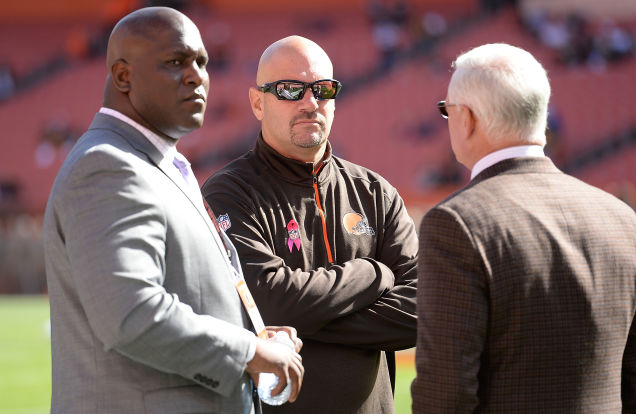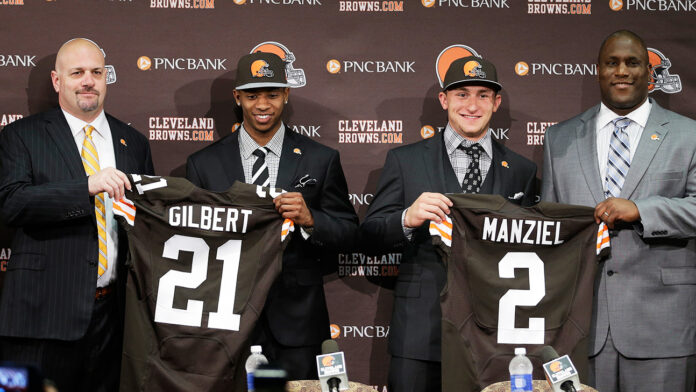Can’t Win if Ownership, Coaching Staff & Management Aren’t on Same Page
When news broke about the NFL’s disciplinary measures against Cleveland Browns’ general manager, Ray Farmer, it was a stark reminder of the ongoing internal struggles that many NFL franchises grapple with regularly.
These battles transpire within the intricate framework of football organizations, pitting the player acquisition division (comprising scouts, GMs, and front office personnel) against the coaching staff.
From an external perspective, one might naturally assume that teams with names like Cowboys, Dolphins, Giants, and others operate as unified entities with a clear direction.
However, in all but the most exceptional circumstances, there exists a clash of interests behind the scenes of most football organizations. While it would be ideal for all parties to always be on the same page, this is not the case.
When this alignment of interests does occur, it results in the creation of enduringly successful organizations, exemplified by the likes of the New England Patriots, Green Bay Packers, Seattle Seahawks, Baltimore Ravens, and Pittsburgh Steelers.
In such cases, egos are set aside for the collective aim of winning, irrespective of who garners the accolades.
This harmony also manifests when the coaching department and front office become almost indistinguishable, thus eradicating the potential for conflict between coaches and the front office.
The New England Patriots, led by Bill Belichick, stand out as a distinctive example of this approach.
One significant factor contributing to the absence of sustained success within organizations is the disconnect between the front office and the coaching staff.
Ray Farmer’s suspension from the first four regular-season games of the 2015 season, stemming from his violation of the NFL’s electronic device policy, derived from his attempt to collaborate effectively with the coaching staff.
Nevertheless, texting feedback during a game not only contravenes NFL regulations but also hampers the effort to foster a shared perspective with the coaching team. It represents a failure to stay in one’s designated lane.
Throughout the tumultuous season of the previous year, it became abundantly evident that Johnny Manziel was Farmer’s preferred choice.
Browns owner Jimmy Haslam disclosed during a Pro Football Hall of Fame luncheon in May last year that it was Farmer who not only decided to draft Manziel but also orchestrated the trade-up, moving from the 26th pick to the 22nd pick to secure him, thus relinquishing the team’s third-round selection.
The departure of offensive coordinator Kyle Shanahan, who took his talents to Atlanta, was driven by reports of an increasing chasm between the coaching staff and the front office.
Could this division have been exacerbated by the unsolicited texts received during a game? It isn’t easy to imagine otherwise. Furthermore, the quarterbacks coach, Dowell Loggains, was also relieved of his duties.

The Forces
Inevitably, a perpetual dynamic of diverging interests exists between the coaching staff and the front office. Navigating this intricate terrain is essential for any franchise aspiring to achieve and maintain long-term success.
From the perspective of the front office, the utmost concern centers on the players they meticulously study, evaluate, and subsequently acquire. Their ultimate aspiration is to be vindicated by the performance of these players.
A strong showing by the players not only ensures job security for the front office personnel but also opens doors to potential promotions and salary increments.
Conversely, coaches share these concerns but are simultaneously driven to validate the efficacy of their specific “system.”
Success for coaches translates into the potential to ascend the coaching hierarchy, with offensive and defensive coordinators eyeing opportunities to assume head coaching positions.
For the head coach, a flourishing system signifies augmented job security and an enhanced bargaining position during contract negotiations.

The perennial issue revolves around the player’s compatibility with the system the coaches intend to implement.
In the NFL, it’s a common occurrence for the front office to develop a strong affinity for a player without a comprehensive understanding of the existing system or whether the coaching staff is willing to adapt their scheme to harness the player’s unique skill set.
This situation often leads to a player’s inability to reach their full potential, as the coaching staff’s reluctance to deviate from their system prevents the player from being utilized to their maximum capabilities.
This predicament is particularly evident in the case of “spread” quarterbacks, such as Cam Newton, Colin Kaepernick, Johnny Manziel, and Robert Griffin III. Despite being highly ranked in their respective draft classes, their career trajectories largely hinge on how they are employed as quarterbacks.
So, the question arises: Why don’t organizations prioritize acquiring the best available players and employing a flexible system that can be adjusted to accommodate the evolving personnel year after year?
While this would be the ideal approach, it often falls victim to ego and the fear of being dispensable—an executive, scout, or coach who perceives themselves as replaceable risks losing their job.
An illustration of this can be drawn from Cleveland’s situation last season. If offensive coordinator Kyle Shanahan had implemented the same offense that Johnny Manziel ran at Texas A&M, it would have necessitated a drastic transformation of the Browns’ system.
This, in turn, could have led to the fear of being seen as expendable. Any success could have been attributed primarily to the front office’s keen eye for drafting talent, diminishing the coordinator’s role.
Harmonizing the front office and coaching staff’s vision is an imperative requirement. Achieving this synergy is paramount for a franchise’s sustained success. In Ray Farmer’s case, his approach to collaboration with the coaching staff was flawed.
A year later, after a series of coaching staff changes, his suspension, and numerous questions surrounding the Browns’ direction, the NFL community has a compelling case study illustrating the critical significance of effective collaboration in the league.

